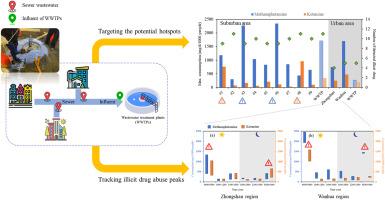Investigating illicit drug hotspots and daily variations using sewer-network wastewater analysis
IF 8.1
2区 环境科学与生态学
Q1 ENVIRONMENTAL SCIENCES
引用次数: 0
Abstract
Previous wastewater-based epidemiology (WBE) research on illicit drug use has predominantly focused on wastewater treatment plant (WWTP) influents, but information on sewer-network wastewater is very limited. This study represents a pioneering small-scale WBE investigation based on the analysis of sewer-network wastewater samples from different sewer manholes in suburban (Tamsui region) and urban areas (Zhongshan and Wanhua regions) and a comparison of the results with those obtained from corresponding WWTP influents. Among sixteen illicit drugs, methamphetamine exhibited the highest concentration in sewer-network wastewater across both areas. Suburban–urban variations were observed, with more types of illicit drugs detected in the suburban area. Back-calculation indicated that methamphetamine and ketamine were the most-consumed illicit drugs in both sewer-network wastewaters and WWTP influents. Similar types of illicit drugs were detected in the sewer-network wastewaters and WWTP influents, indicating the representativeness of WWTP influents in assessing regional illicit drug abuse. Nevertheless, the sewer-network wastewater results offered additional information making it possible to pinpoint potential hotspots of illicit drug and identify peak usage periods throughout the day, in contrast to the WWTP influent results. In the non-suspected suburban area of Tamsui, high potential hotspots of methamphetamine (sampling points 3 and 6) and ketamine (sampling points 1 and 8) were identified. Although the Zhongshan and Wanhua regions were chosen as suspected hotspots of illicit drug abuse, more severe illicit drug use was observed in Wanhua. Moreover, a trend toward higher illicit drug use from early morning to morning was observed. Despite sampling challenges and higher costs, small-scale WBE via sewer-network wastewater analysis provides superior identification of drug abuse hotspots and peak usage periods. Therefore, this study provides valuable insights for law enforcement and can help prevent and combat illicit drug abuse by targeting potential hotspots and understanding daily illicit drug use dynamics.

利用下水道网络废水分析调查非法药物热点和每日变化。
以往有关非法药物使用的废水流行病学(WBE)研究主要集中在污水处理厂(WWTP)的进水方面,但有关下水道网络废水的信息却非常有限。本研究是一项开创性的小规模 WBE 调查,它分析了来自郊区(淡水地区)和市区(中山和万华地区)不同下水道井的下水道网络废水样本,并将结果与相应的污水处理厂进水进行了比较。在 16 种非法药物中,甲基苯丙胺在这两个地区下水道网络废水中的浓度最高。郊区与郊区之间存在差异,郊区检测到的非法药物种类更多。反向计算表明,甲基苯丙胺和氯胺酮是下水道网络废水和污水处理厂进水中消费量最大的非法药物。在下水道网络废水和污水处理厂进水中检测到的非法药物种类相似,这表明污水处理厂进水在评估区域非法药物滥用方面具有代表性。不过,与污水处理厂进水结果相比,下水道网络废水结果提供了更多信息,使我们有可能确定潜在的非法药物热点,并确定全天的使用高峰期。在淡水的非可疑郊区,发现了甲基苯丙胺(采样点 3 和 6)和氯胺酮(采样点 1 和 8)的高潜在热点。虽然中山和万华地区被选为疑似非法药物滥用的热点地区,但在万华地区观察到的非法药物滥用情况更为严重。此外,还观察到从清晨到上午非法药物使用率较高的趋势。尽管取样困难且成本较高,但通过下水道网络废水分析进行的小规模水质检测能更好地识别药物滥用热点和使用高峰期。因此,这项研究为执法部门提供了宝贵的见解,并可通过锁定潜在热点和了解日常非法药物使用动态来帮助预防和打击非法药物滥用。
本文章由计算机程序翻译,如有差异,请以英文原文为准。
求助全文
约1分钟内获得全文
求助全文
来源期刊

Chemosphere
环境科学-环境科学
CiteScore
15.80
自引率
8.00%
发文量
4975
审稿时长
3.4 months
期刊介绍:
Chemosphere, being an international multidisciplinary journal, is dedicated to publishing original communications and review articles on chemicals in the environment. The scope covers a wide range of topics, including the identification, quantification, behavior, fate, toxicology, treatment, and remediation of chemicals in the bio-, hydro-, litho-, and atmosphere, ensuring the broad dissemination of research in this field.
 求助内容:
求助内容: 应助结果提醒方式:
应助结果提醒方式:


